 |
| Photo from Ray's LaSalle County Online Museum |
The predecessor bridge was one of the first parts built for the land-grant Illinois Central in 1850. But the route up the center of the state, as opposed to the "branch" from Centralia to Chicago, was abandoned by ICG. The cement company south of the river formed the railroad PVTX to save the bridge which was part of the rail segment from its plant on the south to a connection with the CSX/Rock Island on the north.
The reason for "1890s" in the title is because I have seen the dates of 1893 and 1896. The lift span "was added in 1931-32 as part of the Illinois Waterway project that opened the river above LaSalle to barge traffic." [Harold J. Krewer comment on a photo in a post]
Of the three railroad bridges over the Illinois River between Lasalle, IL and DePue, only this one is left. (II&I and IV&N are the two lost bridges.)
Of the three railroad bridges over the Illinois River between Lasalle, IL and DePue, only this one is left. (II&I and IV&N are the two lost bridges.)
 |
| Andy Zukowski posted The CB&Q on the right heads towards the Illinois River in LaSalle, Illinois with the Mile Long Bridge in the Background (Illinois Central Railway). Frank Stokes: Was the CB&Q bridge a lift bridge and when was it torn down? The IC bridge looks different, was it rebuilt after this picture? Gary Sprandel: Frank Stokes it was converted to a standard lift from a scissor lift ( hinged arms that lifted the span vs towers)in 32. IIRC the main span on the IC bridge would be a bit behind the locomotive on the train so it might be between 32 and when the IC bridge was modified for the waterway project a few years later. From what I was able to dig up dismantling began in 80. Thomas Whitt shared |
 |
| Andy Zukowski posted The CB&Q Railroad on the right heads towards the Illinois River in LaSalle, Illinois with the Mile Long Bridge in the Background (Illinois Central Railway). |
 |
| Matt Edwards posted Flying over the river near Oglesby and I-39 in January of this year. |
.jpg) |
| John Fesco posted, cropped The mile-long railroad bridge, looking south. |
 |
| John Fexco posted The “mile-long” bridge. North shore looking west. David Hahn shared |
 |
| Robert Faletti posted Going upstream by the Mile Long RR bridge,LaSalle 2023 Eric Rice: Upstream yep, on the inland rivers we call that N/B or Northbound . S/B is Southbound or downriver . [I've noticed that usage on the Ohio River. It has to be a little confusing on the Tennessee River.] |
 |
| Robert Faletti posted The Mile Long RR Bridge with Shippingsport Bridge under it, looking west on the Illinois at LaSalle. |
The first bridge was constructed in 1853-54 by the Illinois Central as part of its chartered mainline up the center of the state between Cairo and Galena that was supported with land grants to help populate the state. The bridge is an impressive engineering feat because it goes from bluff to bluff. That is, it is high and long. Its construction benefited from the fact that it goes over the I&M Canal, so it was easy to move in people and supplies because the canal had opened just a few years earlier (1848). In fact, the bridge was part of the first segment that was constructed --- La Salle to Bloomington. (La Salle History, p35,37) and helped carry supplies, such as rail from England, to the more remote construction sites
 |
| Larry Foht posted, cropped Illinois Central Railroad Bridge LaSalle Illinois While researching this Bridge I uncovered so much history related to it. It connects Freeport Illinois to Cairo Illinois down the middle of the whole length of the State. Abe Lincoln was a attorney for the Illinois Central from: 1850-1860 He traveled it, it is said across this bridge. Makes sense he traveled north on the Line to Freeport for the Lincoln, Douglas Debate. There are record's at Amboy showing records and manifests of the Roads involvement in the Civil War. Thousands of Soldiers there equipment, supplies went south across this Bridge. Records at Amboy show on December 10, 1862 a train with 2 passenger Cars and 31 freight cars loaded with Soldiers went south. This is said to have happened many times and sometimes with little notice !! The last of my 3 photos shows a freight, with freight cars. Almost the makeup of the troop Train. My findings that I have written come from many sources. A photo that I came across similar to the ones shown is of a engine and tender saying the time was the 1870s. Please go on and do your own research about the bridge and IC. Larry Foht collection: |
I made these smaller when I got the better photo exposure. And you can see what the photo looks like when it is not cropped.
 |
| Bill Molony posted A long Illinois Central freight train on the trestle at La Salle, Illinois - 1874. Bill Molony shared |
 |
| Richard R. Anderson commented on Bill's share Love it! Did a little toning. |
 |
| Raymond Storey posted |
The bridge is about 12 years old in this view (Ray's LaSalle County Online Museum (RLCOM)). Note the aqueduct for the I&M Canal, the Rock Island bridge, and the Rockwell Road bridge over the Little Vermillion River. The Library of Congress Historic American Engineering Record (HAER) confirms this first bridge was a Howe truss.
This view emphasizes the length of the bridge and displays the stonework in the piers. The bridge must have already been rebuilt because this is a Pratt truss (vertical compression members) instead of a Howe truss (diagonal compression members). The caption reads: "The Illinois Central Bridge, for its day, was a masterpiece of engineering. It was opened to railroad traffic late in August, 1854. In 1893 this bridge, with exception of the piers, was entirely rebuilt, span by span, without interrupting train schedules."
They have completed the first span and are working on the second one. During the 1898 grand opening, citizens were allowed to
walk across the bridge.
On the south side of the river, there is a long fill from the river's edge to the bluff near Jonesville, IL. It is hard to see because of the shadow cast by I-39, but the fill is almost as high as the trees growing from the flood plain in front of the fill.
The 1910 flood answers the question of why they didn't use a fill on the north side of the river. Fills on both sides of the river would have effectively been a dam with a spillway that was too small to handle the flow of a flood.
When the Army Corps of Engineers added dams and locks to the Illinois River in the 1930s to provide a 9-foot navigation channel, it had to add lift spans to most of the bridges across the river. But for this bridge the tracks were high enough that they could replace a couple of deck trusses with a Parker through truss.
The photo on the right shows the construction of the reenforced concrete pier for the south side of the new Parker truss. RLCOM has several more construction pictures. If you look at the old piers in the 1932 pictures, you can see that they now have a concrete pillar on top.
Some sources indicated that the level of the tracks were raised in 1932 to provide the needed clearance for the shipping channel.
But if you compare Steve's photo with the 1800s photos, I believe the old stone pillar was replaced with a concrete pillar. On one of the blueprints on the RLCOM site I found this notation:
So I assume the concrete work on the piers was done in 1916. In 1920, the deck plate girder span was installed over Rockwell Road (HistoricBridges).
The ravages of time have not been kind to the old swing span pier. You can tell that the upstream side bears the brunt of the rivers current because it has seen the worse wear. Seeing how badly it is worn today would be a good excuse for a field trip to get my own pictures.
(Update: Ray has a photo of the main truss from the downstream side.) The towboat caught my eye because it has a cabin that can be lowered for low bridges. It is strange that one of these would be so far downstream. They are needed for the bridges on the Chicago Sanitary and Ship Canal upstream of Lemont, IL. But all of the bridges on the Illinois River are supposed to have 50 feet of clearance or be movable.
I'm more interested in the technology of industrial history than the politics, lawyers, and greed of industrial history. But the people aspect is an important part of the history, so I include a description of the labor unrest that occurred while building the fill on the south side. Remember that construction during the 1850s was very labor intensive. Basically, it was picks, shovels, and wheelbarrows.
I include this photo because it is pretty, and it shows a cement train heading to the plant.
I include this shot that frames the PVTX bridge with the 2003 Shippingsport Bridge because it shows all three bridges in the La Salle area --- IL-351, the PVTX/IC RR bridge, and I-39's Abraham Lincoln Memorial Bridge.
William's comment:
 |
| Photo from Bridge Hunter Andy Zukowski posted Photo showing the ICRR Illinois River Bridge, Little Vermillion Aqueduct and Rockwell Road Bridge in LaSalle. William Wroblewski Notice the lack of trees David Hahn shared Harold J. Krewer Not to mention a single-track Rock Island and a not-even-built yet interurban line. The IC bridge does not have the current deck truss spans, so that puts this photo prior to 1893. I would say the single-track RI makes it even before that, but don't have an exact date for double-tracking handy. Gilbert Sebenste And the rock cliff was taken out as well that the guy is sitting on, on the far right. |
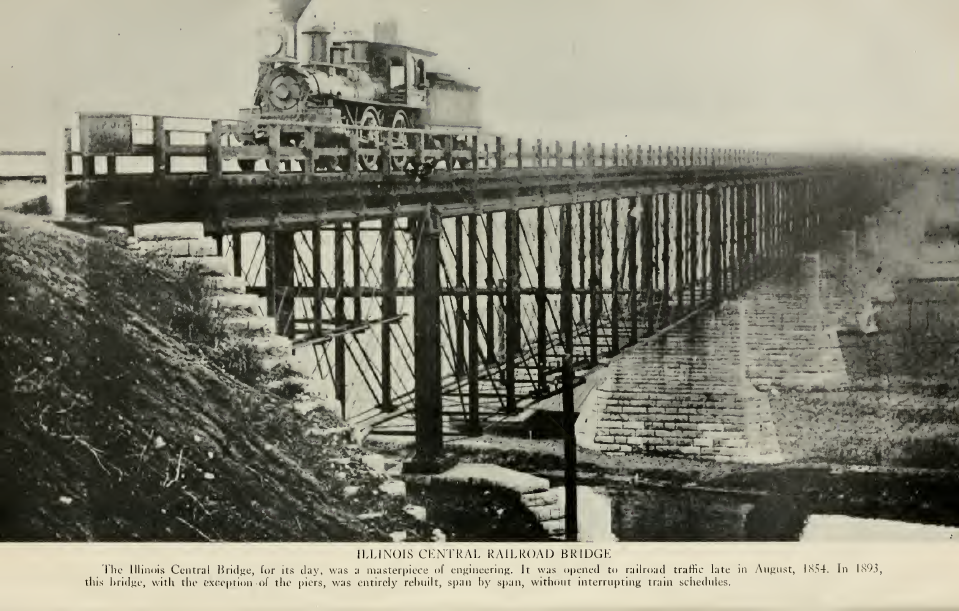 |
| La Salle History, p36 Michael Nieslawski posted David Hahn shared William Wozniak The Original Illinois Central Bridge before the 1893 rebuild. |
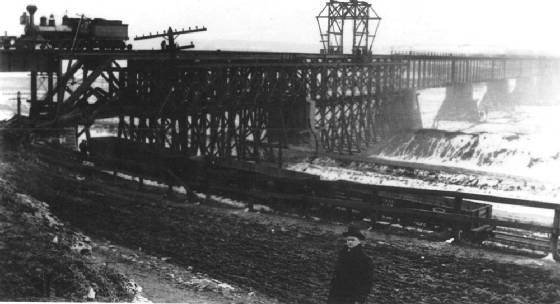 |
| Photo from RLCOM |
 |
| Photo from RLCOM |
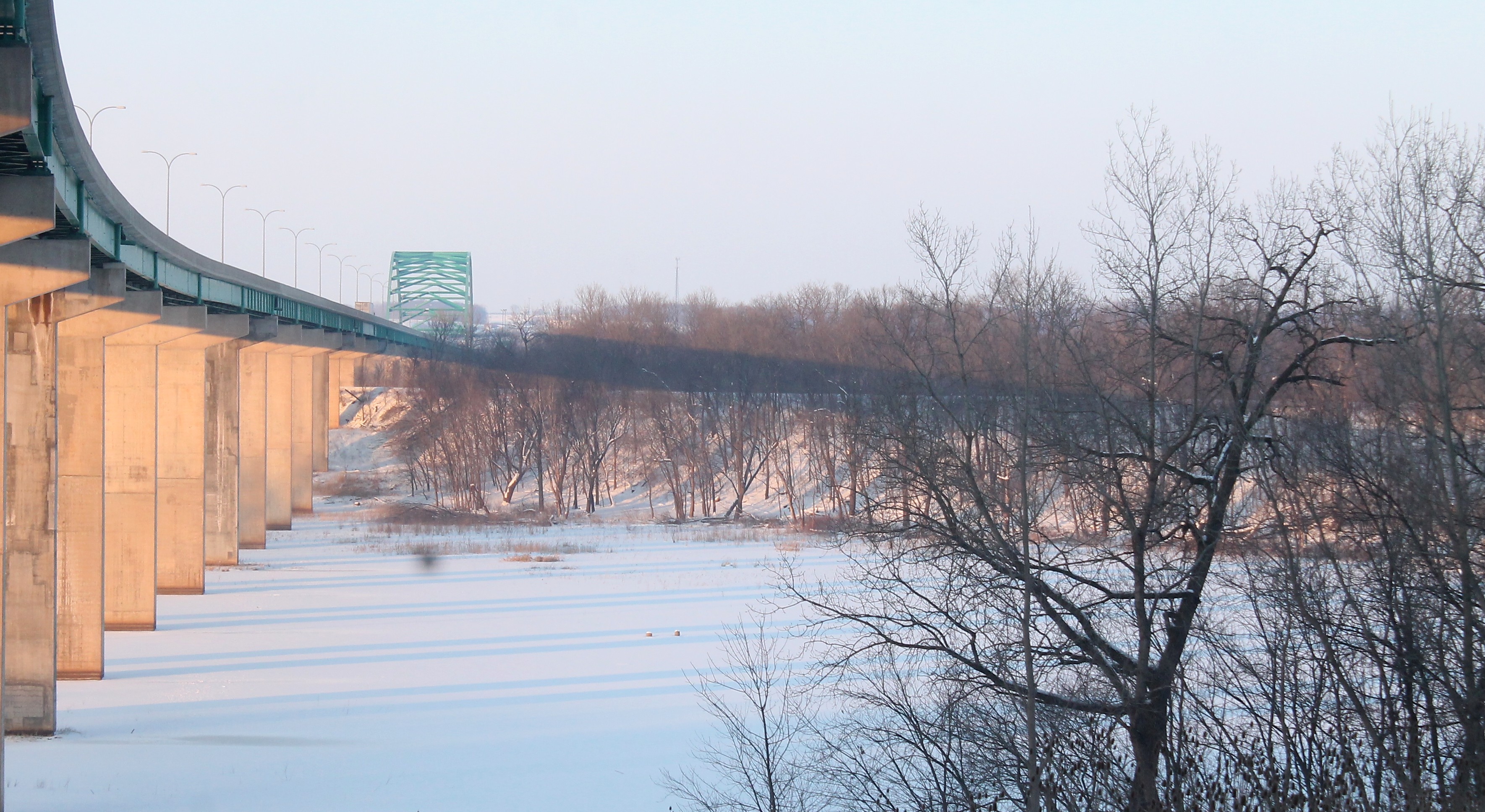 |
| Photo from RLCOM |
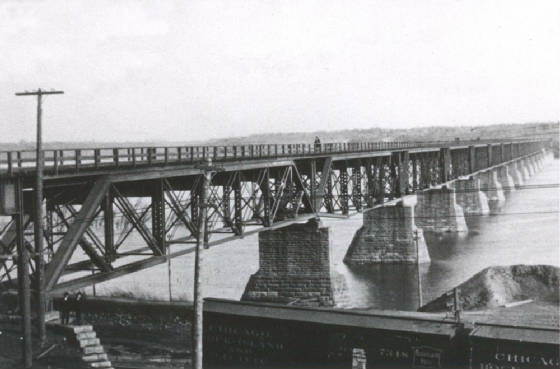 |
| Photo from RLCOM |
When the Army Corps of Engineers added dams and locks to the Illinois River in the 1930s to provide a 9-foot navigation channel, it had to add lift spans to most of the bridges across the river. But for this bridge the tracks were high enough that they could replace a couple of deck trusses with a Parker through truss.
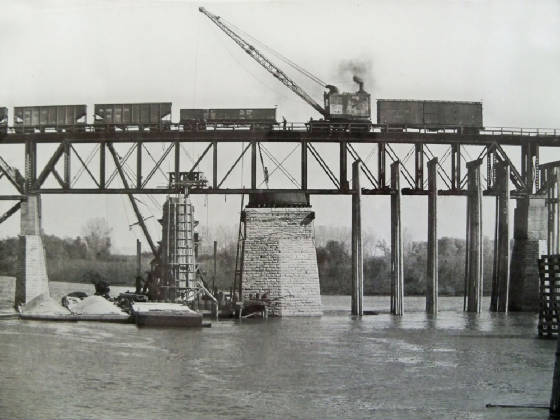 |
| Photo from RLCOM |
 | ||
| Photo from HAER |
Some sources indicated that the level of the tracks were raised in 1932 to provide the needed clearance for the shipping channel.
 |
| Photo by Steve Conro from BridgeHunter |
But if you compare Steve's photo with the 1800s photos, I believe the old stone pillar was replaced with a concrete pillar. On one of the blueprints on the RLCOM site I found this notation:
 |
| Blueprint form RLCOM |
The ravages of time have not been kind to the old swing span pier. You can tell that the upstream side bears the brunt of the rivers current because it has seen the worse wear. Seeing how badly it is worn today would be a good excuse for a field trip to get my own pictures.
 |
| Photo from BridgeHunter: downstream side |
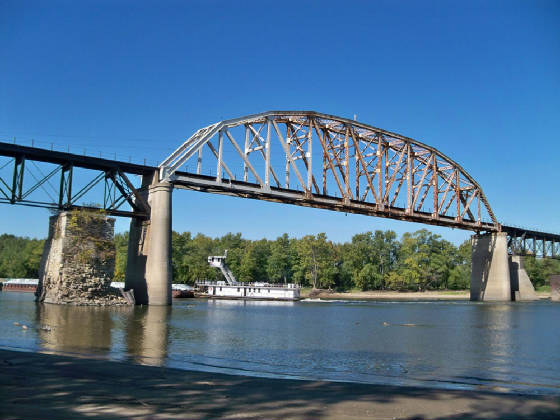 |
| Photo from RLCOM:upstream side |
(Update: Ray has a photo of the main truss from the downstream side.) The towboat caught my eye because it has a cabin that can be lowered for low bridges. It is strange that one of these would be so far downstream. They are needed for the bridges on the Chicago Sanitary and Ship Canal upstream of Lemont, IL. But all of the bridges on the Illinois River are supposed to have 50 feet of clearance or be movable.
I'm more interested in the technology of industrial history than the politics, lawyers, and greed of industrial history. But the people aspect is an important part of the history, so I include a description of the labor unrest that occurred while building the fill on the south side. Remember that construction during the 1850s was very labor intensive. Basically, it was picks, shovels, and wheelbarrows.
While the bridge was under construction, a serious difficulty arose between the men
and the contractor, Albert Story. On December 15, 1853, a force of approximately 450
men was employed on the excavations and the embankment on the south end of the
bridge. A dispute had arisen over wages. The men said that they had come from the
East to La Salle assured that they would receive a daily wage of #1.25, and for a while
they had been paid that amount. In December, Mr. Story announced that after December
15th the daily wage would be $1.00, and that those who were dissatisfied with that
wage would, on December 15th, be paid off and discharged. The men, on the other hand,
stated that they had spent all their means to reach central Illinois, that the promise of
wages had been violated, and that, unless they were willing to work at a reduced rate,
they, with families to provide for, would be unemployed in the winter. On the date set,
when the clerk commenced to pay the men, some error was found in the payroll, and
immediately the payments were stopped. Incensed at what they regarded as a breach
of faith, the men rushed into the office and declared that they themselves would take
over the payroll. In the scuffle which followed, one of the men struck Mr. Story.
Meanwhile, a superintendent of the work. Colonel Maynard of Chicago, left through
a back exit to protect Mrs. Story and the Story children. While Colonel Maynard was
gone, the assailants were forced from the office, and the door was bolted. The men with
axes, picks, and shovels then broke down the door, and one man re-entered. Mr. Story
was armed, and he inquired of his clerks concerning the advisability of shooting. The
clerks recommended that they all remain quiet.
Story, who did not know that Colonel Maynard had gone to take care of Mrs. Story,
then left through the back exit to go to the house. On arriving there, he found that his
wife and children had been taken away; immediately he started for the stable to get a
horse on which to leave the place. The men, seeing him, rushed shouting toward the
stable. With picks, shovels, and stones, they brutally and almost instantly murdered
him. It had been asserted that Story fired into the crowd, but there has never been any
conclusive proof of the statement.
By this murder, the entire county was aroused. The news quickly reached La Salle,
and a telegram was sent to Ottawa for Sheriff Thorne who arrived with a company of
militia at about seven o'clock on the same evening. Mayor Alexander Campbell and
about a hundred citizens accompanied the sheriff to the scene of the murder. When they
reached the spot, they found that a number of men was in the neighboring hills, and that
some of them were armed. The militia fired on them; one man fired on the sheriff's men,
but he was shot twice in the arm and then taken prisoner.
The sheriff went through the shanties and arrested sixty or seventy men; about thirty
or forty were recognized as participators in the disturbance, though none had actually
committed the murder. The grand jury subsequently found true bills against twelve of
the leaders. Four of the men, James Terry, Michael Terry, Koven Brennan, and Martin
Ryan, asked for a change of venue to Kane County and were found guilty of murder. At
a new trial, the same verdict was returned, and the men were sentenced to death. This
sentence was, however, commuted by Governor Matteson to life imprisonment. Before
he left office, the governor granted a full pardon to the men. This move was so unpopular
that when Mr. Matteson later visited La Salle, he was publicly burned in effigy.
When Sheriff Thorne returned to Ottawa on December 15th, he left at La Salle a
portion of his force as a permanent guard. The work on the bridge was continued by new
contractors and laborers, and during the remainder of the construction period, the area
around the bridge resembled a military camp. (La Salle History, p37)
I include this photo because it is pretty, and it shows a cement train heading to the plant.
 |
| Public Domain: Upstream Profile from Bridge Hunter by Gene Smania |
 |
| Photo by John Weeks III |
 |
| William Wozniak -> Illinois Central Charter Line |
This picture comes from a very good friend of mine Ray Tutaj Jr..(William C, Schlosser)
 |
| Andy Zukowski posted Illinois Central Railway Bridge (Mile Long Bridge) When the center was a swing bridge. I believe the photo was from 1894. A Ray Tutaj photo |
A darker exposure
 |
| William Wozniak -> Illinois Central Charter Line Here is a photo from my friend Ray Tutaj Jr on the "Original IC bridge" before the 1893 rebuild of the bridge at LaSalle.... |
Jay Tutaj Jr. posted some contemporary pictures of the Buzzi Unicem operation.
Raymond's comment:
Bill Molony also posted this picture with the comment: "An Illinois Central freight train paused on the bridge over the Illinois River at La Salle, Illinois, in 1874." And he posted again in May, 2017.
William Wozniak posted two pictures with the comment: "The IC Bridge had a swing span ive noticed looking over Ray's blueprints............1932 they took the swing out and pier #6 is still standing after all these years....(Ray Tutaj jr credit)my dad to this day still thinks i'm full of crap about this...heres THE PROOF RIGHT BELOW......!!!!"
Christie Pasieka posted three images with the comment:
An image from my friend Bill Schlosser. Shows an IC special in La Salle heading down to Champaigne Urbana for a football game. I am not sure about the date or other details. I am guessing in the late 1950's?Karl Rethwisch commented about how good the Rock Island main looked back then.
 |
| Raymond Tutaj Jr. posted |
 |
| Jon Hill posted in Facebook |
 |
| William Wozniak posted LaSalle IL late 1970's.....The BN bridge over the river at LaSalle IL awaits its final FATE!!! Dave Woz photo. [It's fate is that it was bought and is maintained by Buzzi Unicem.] |
 |
| William Wozniak posted ICG Solid Orange Northbound over the Illinois River coming into LaSalle.....1982... .Dave Woz photo |
 |
| William Wozniak posted Gulf Mobile and Ohio Leader on a ICG Southbound getting ready to cross the river at LaSalle on the Amboy District in 1981...Dave Woz photo. [It is passing over the old Illinois & Michigan Canal.] |
 |
| Bill Molony posted A northbound Illinois Central Railroad freight train on the high bridge over the Illinois River Valley at La Salle, Illinois - 1874. Dennis DeBruler The I&M Canal in the foreground was probably still in use back then. And it is nice to see the old truss bridge. Now the bridge is obscured by trees. Ben Burch Notice the brakeman on the car 2/3 of the way back. Pre air brake... Richard Fiedler Shows just how deadly dangerous things were then. Life was indeed cheap. |
William Wozniak posted two pictures with the comment: "The IC Bridge had a swing span ive noticed looking over Ray's blueprints............1932 they took the swing out and pier #6 is still standing after all these years....(Ray Tutaj jr credit)my dad to this day still thinks i'm full of crap about this...heres THE PROOF RIGHT BELOW......!!!!"
 |
| 1 |
 |
| 2 William Wozniak posted, several comments William Wozniak shared David Hahn shared |
 |
| William Wozniak posted Illinois Central RR Bridge rebuild...late 1890s. David Hahn shared |
Christie Pasieka posted three images with the comment:
Question was asked if piling was used under the ICRR Bridge. Below is what I found. I saw no notation of piling driving in in the rebuild, but there is a machine on top of the bridge on the rebuild, so not sure. The stone pier built in 1851 was replaced with concrete. The concrete would have had rebar in it.
Mike Dimond. William Wroblewski
 |
| 1 |
 |
| 2 |
 |
| 3 |
 |
| Mike Dimond commented on Christie's post When the Army Corps of Engineers added dams and locks to the Illinois River in the 1930s to provide a 9-foot navigation channel, it had to add lift spans to most of the bridges across the river. But for this bridge the tracks were high enough that they could replace a couple of deck trusses with a Parker through truss. In the photo titled photo from RLCOM we see temporary pilings used to build the Parker through truss. They were removed once construction was complete. https://industrialscenery.blogspot.com/.../pvtxic... |
 |
| Raymond Tutaj Jr. posted Circus train crossing the ICRR bridge at La Salle IL. an image from the Steve Shutt collection/archives. I am not sure what year. My guess is late 60's to early 1970's. Mr. French says late 50's or early 60's. I agree. Jim French I'd say late 50's or early 60's. I believe the bridge was painted silver in the first half of the 60's.Chet French I recall seeing a circus or carnival train go south through Dixon in the early 1960's. It was about 10PM, so that train probably would have gone through LaSalle in the dark. I recall another train in the early 1960's moving from the Wisconsin State Fair to the Illinois State Fair that came down the Gruber. |
 |
| 20150807,08 3844 |
 |
| William Wozniak posted man i keep re-posting this shot but who gives a crap?......1979 RI Eastbound ducking under the IC bridge on the east end of LaSalle, IL [With the I&M Canal on the left. Taken from, rather than of, the IC bridge.] |
 |
| 1 |
 |
| 2 |
 |
DNE 31 FlickrLONESTAR CEMENT 1616 @ LASALLE, IL (6) 03/2011Lonestar Cement 1616 south bound with loads crossing the Illinois River on the X-IC Gruber Line bridge 03/2011 |
 |
| William Wozniak posted ICG solid orange scheme. Northbound for LaSalle. |
Two photos posted by Trenton Dominy with the comment: "The remains of the Gruber line in Mendota Illinois and LaSalle Illinois."
Ron Frazier posted two photos.
 |
| 2 |
Christie Pasieka posted two photos with the comment:
Illinois Central Bridge LaSalleMy question: In the first photo why does the metal edge go up at the 6th outside post.
Thomas Tipton: Christie Pasieka They don't go up. Optical illusion. They go out with an additional board on the inside.
Bill Crossman: Guessing it’s over the road …that would keep tools etc. from falling off the bridge onto the road/ people when working there …
Robert Hardy: Bill Crossman yes. first trestle from over the road.
 |
| 1 |
 |
| 2 [To the right of the locomotive is the lift span of the CB&Q Bridge.] |
Barry Lennon Flickr 1964 Photo showing three GP9's pulling a northbound over the north flood plane. There were not very many trees back then to obstruct the view of the bridge.
First of three Flickr photos
A couple of videos of a Buzzi GP9 taking loads across the bridge.
John Joseph Walsh III posted a couple of videos with the comment:
Flickr of cement train in 2011 with eight hoppers
John Joseph Walsh III posted a couple videos of a cut of cars going to the plant.
Todd Nemeth How often do they run?
John Joseph Walsh III Todd Nemeth Monday's for sure and I think Wednesdays or Thursdays
A couple of drone shots from south of this and the I-39 bridge
First of three Flickr photos
A couple of videos of a Buzzi GP9 taking loads across the bridge.
John Joseph Walsh III posted a couple of videos with the comment:
Today I noticed the Iowa Interstate BUSW (Bureau switching job) head towards Utica, IL so I figured I would wait until it comes back with loads for Buzzi Unicem which owns the La Salle Railroad bridge and a portion of the former Illinois Central to Oglesby. I walked up the I&M Canal path and saw 701 and 715 (GP38-2s) pulling a decent cut of hoppers stopping not far to the west. They then shoved 11 cars at a time up the grade to the yard just north of the bridge. 03/12/19So do they divide the loaded hoppers into 11-car cuts because of the hill from IAIS to the PVTX yard or is it because of this hill up the river bank to the cement plant?
 |
| Screenshot @ -0:58 John Joseph Walsh III posted While on my way home from work on I-39 02/22/19 I noticed the GP9R from Buzzi Unicem in Oglesby, IL cross the old La Salle Railroad Bridge which used to carry the Illinois Central charter line that has been gone for 30+ years. Once they picked up a cut of cement cars they headed back south across the bridge when I saw them pull hard up a steep incline from Illinois 351. CSX brings the cars via the New Rock sub to Utica where the Iowa Interstate BUSW (Bureau Switcher) picks them up and drops them off at the yard just north of the bridge in La Salle, IL. |
(new window)
(new window) Jeremy J Schrader shared
At 2:30 I noticed that it looks like they have done some work on some of the piers. Also you can see the abandoned swing bridge pier.
(new window) Jeremy J Schrader shared
At 2:30 I noticed that it looks like they have done some work on some of the piers. Also you can see the abandoned swing bridge pier.
 |
| Screenshot @ 0:24 |
 |
| Andy Zukowski posted Illinois Central & Gulf at La Salle, Illinois. C.1982 Harold J. Krewer: That's later than 1976. The former Rock Island has been single-tracked, so this is no earlier than 1982 or 83. The ICG stopped running through trains on the Gruber not long after that, so this is a pretty narrow slice of time! |
 |
| Charlie Ortiz commented on Andy's post Geeps still [2025] roam the old ic...... |
 |
| John Fesco posted The “mile long.” Lloyd Scott Hardin: The nightmare when southbound in high water with 15 barges and towing vessel. Called LaSalle upper bridges along with the I-39 Lincoln memorial bridge |
 |
| John Fesco posted Another shot of the “mile-long” in La Salle. Taken from the north shore. Marek Gawelek: Where is it? Dennis DeBruler: Marek Gawelek A former Illinois Central bridge. It is now owned by a cement company, https://maps.app.goo.gl/HEQmx3DYsnqwYqbL6. |
Flickr of cement train in 2011 with eight hoppers
John Joseph Walsh III posted a couple videos of a cut of cars going to the plant.
Todd Nemeth How often do they run?
John Joseph Walsh III Todd Nemeth Monday's for sure and I think Wednesdays or Thursdays
A couple of drone shots from south of this and the I-39 bridge
27 photos posted by John Joseph Walsh III in the private group Illinois Central Railroad Heritage Association



No comments:
Post a Comment